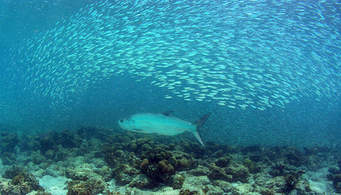March Orlando Area and Mosquito Lagoon Coastal Fishing Outlook
As the days grow longer and the ocean begins its gradual warming phase, (68 to 72-degree range), the spring fishing bonanza on the east central coast of Florida kicks in. Thus far we’ve experienced a warmer then normal winter and as of this correspondence (February 24, 2019) the water temperature at the Canaveral Nearshore Buoy Station 41113 is 68.7 degrees. As usual, weather will serve as the determining factor in establishing the magnitude and progression of the bite and the predator species we love to catch.
Increasing water temperature will facilitate the progression of bait pods (Atlantic menhaden or pogies) from the deeper water into the near-shore waters bringing the predator species with them. As always, sea and weather conditions will determine the number of fishable days we’ll experience in March. This is especially true for those of us who target ocean species in shallow water boats. We have already experienced some good cobia days and an excellent tripletail season which should only get better and migrating fish move into our area from the south.
Nearshore Port Canaveral
Other near-shore options in March consist of tripletail hanging on floating structure and weeds and large redfish, jacks and sharks shadowing bait pods along the beaches and in the inlets around mid-month. When site fishing for cobia and tripletail, consider fishing in the latter part of the day when the sun is overhead as the water is warmer and visibility is better. Also, keep a sharp eye out for large manta rays shadowed by cobia and always keep a chartreuse colored buck tail in the ready position to cast at any brown clowns wondering into casting range. Along the beaches and around the inlets look for snook in close to structure and a mixture of pompano, whiting, sheepshead, bluefish, Spanish mackerel, redfish and black drum in close to shore.
Inshore Mosquito Lagoon

As our water warms up and the silver mullet returns to the inshore lagoon flats, look for redfishschools to continue to form up in the skinny water. For the slot redfish, 18 to 27 inches, focus on areas of flipping and jumping baitfish (mullet) in water depths of 12 to 18 inches. For the larger redfish, concentrate your efforts along deeper edges of the flats and sandbars in 2 to 3 feet of water. Also, sea trout will continue to hold in the skinny water potholes, and the top-water sea trout bite will improve as the warmer water draws finger mullet back onto the central IRL flats. Additionally, schools of black drum will continue to inhabit the shallow water flats of the Mosquito Lagoon, North IRL with the larger black drum holding in the deeper channels and around bridge structures.
St Johns River Freshwater

Finally, the American shad run is waning on the upper St John’s River between the areas of Lake Harney and the SR 50 Bridge, as this years run has been slow to say the least. March is also the month to start targeting schooling largemouth and sunshine bass in the deeper bends of the river at first light feeding on schools of baitfish (threadfin shad). The indicator I use to locate these schooling bass is to look for large numbers of white pelicans, herons, and egrets working the banks. Once you’ve located the schooling fish, try throwing a 6” DOA Shad Tail on top or a rattle-trap or other small subsurface swim bait into the mix. Last year the bass fishing did not materialize in areas south of Lake Jessup, so I’m hoping for a better season this year. Water levels this spring on the St Johns River are currently dropping out, but a good spring rain event could easily turn that around.
Spring is one of the best times to fish the Indian River Lagoon coast of Florida. So, if you are planning to visit the area, make sure you book your hotel and fishing guide early. Also, when the bite is on, the ramps fill up quickly, so arrive early, be polite and considerate with other anglers, because we are all on the water for the same reasons, to have fun and catch fish.
As always, if you need information or have any questions, please contact me.
Good luck and good fishing,
Captain Tom Van Horn
407-416-1187 on the water
To book a charter, simply visit the Reservations Page on my website and follow the prompts.
- The Neil Blog - March 23, 2024
- ++++++++++++++++++++++++++++++++++++++++++++++++++++++++++++++++++++++++++++++++++++++++++++++++++++++++++++++++++++++++++++++++++++++++++++++++++++++++++++++++++++++++++++++++++++++++++++++++++++++++++++++++++++++++++++++++++++++++++++++++++++++++++++++++++++++++++++++++++++++++++++++++++++++++++++++++ - June 25, 2023
- Nature Coast:William Toney - December 12, 2021











